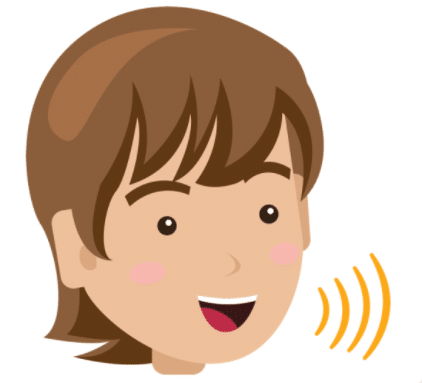Verbal communication is the use of words to exchange information with others. As a result, it could include both oral and written communication. However, many people use the term to refer to only oral communication. The verbal component of communication is concerned with the words you choose as well as how they are heard and interpreted.
- The Importance of Verbal Communication
- The Elements of Verbal Communication
- The Four Different Types of Verbal Communication
- Foundation of Verbal Communication
- The Drawbacks of Verbal Communication
- How to Improve Your Verbal Communication Capabilities
- The Importance of Teaching Communication Skills to Children
- 5 Ways to Teach Children Communication Skills
- How to Recognize Communication Difficulties in Children
- Final Thoughts
- FAQs
- What is the difference between verbal and nonverbal communication?
- What is the definition of verbal communication skills?
In this article, we will look into the importance, the different types as well as tips on how to improve verbal communication.
The Importance of Verbal Communication

The following reasons depict the importance of verbal communication.
- Maintaining successful business partnerships requires excellent verbal communication skills. Productivity rises, errors fall, and operations go on more smoothly as a result of effective communication.
- The way employees connect with one another reflects an organization’s image.
- Employees with good verbal communication skills build outstanding business partnerships with other clients, firms, suppliers, and so on.
- Good verbal communication in the workplace is crucial for firms with a varied workforce. Furthermore, it contributes to the reduction of obstacles caused by cultural and linguistic differences. Many global corporations provide training to their staff in order to instil strong communication skills, which prove to be quite advantageous in the long term.
- Effective verbal communication between employer and employee boosts job satisfaction.
- Individuals with excellent verbal communication abilities have a greater ability to exchange ideas, thoughts, and concerns with one another.
- You can form strong interpersonal bonds through verbal communication. It’s easier to meet like-minded folks who have comparable hobbies, views, and perspectives. This motivates you to cooperate, collaborate, and work as a team.
- Because verbal communication allows for feedback, you can clarify your point by repeating yourself. In confrontations or arguments, for example, you can repeat your statement so that there is no opportunity for ambiguity.
The Elements of Verbal Communication
There are several things that assist us in organizing our ideas around it. These are known as the elements of verbal communication. They are as follows:
Tone

The tone with which you express yourself influences the message you convey. For example, you may be saying something pleasant, but if your tone is sardonic, the message might be transmitted in a different way. Your tone of voice has a significant impact on your speaking.
Speed
The rate at which you talk is crucial because it impacts how your audience reacts. You may have attended seminars or webinars where individuals speak slowly and quietly. This might get tedious. Similarly, someone speaking quickly may be difficult to comprehend.
Volume

The loudness at which you speak can express a variety of messages. For example, if you whisper something into someone’s ears in front of a group of people, it may be misinterpreted. Screaming during a conversation, on the other hand, is impolite. Always keep an eye on your volume based on the social situation.
Grammar and Vocabulary

Language, grammar, and vocabulary are also important parts of verbal communication. For example, sending an incorrect message to a recruiting manager can make or break your career potential. This is why verbal communication is such an important ability for success in professional settings.
Mediums
Face-to-face or public verbal communication are the two different types of mediums. Face-to-face communication allows communicators to freely express ideas, whereas public speaking allows for the interchange of ideas only in particular conditions, such as a school setting or during a question-and-answer session. However, in order to maintain information flowing easily and clearly between the speaker and the audience, rules regarding when each participant can talk must be negotiated.
Sound
Everyone has the ability to make noises. Some sounds, such as laughing, sobbing, and yelling, have nothing to do with language or words. Regardless, people who speak other languages can grasp the sentiment that the individual is trying to express.
Words

At some point of time, children learn to combine sounds to form words. Words are sounds created in such a way that they can be distinguished from other sounds. Because not everyone can grasp the meaning of each specific word, people intending to communicate verbally must ensure that those to whom they are speaking understand the intended meaning of the word.
Language
Individuals who desire to interact verbally with those who speak another language must not only learn the language but also comprehend how these words are utilized in everyday conversation. For example, a person learning English may know that the word ’accelerated’ is a synonym for ‘fast’, yet ‘accelerated’ refers to a certain type of ‘fast’ in which an individual performs an action faster than before.
Etiquette
In addition to comprehension, different cultures have etiquette standards that govern what is spoken in order to prevent offending others. For example, speakers tend to address their audience as ‘ladies and gentlemen’. On the other hand, individuals frequently address one other as ‘sir’ or ‘madam’ in face-to-face interactions.
The Four Different Types of Verbal Communication
When you use multiple methods of communicating, you can more effectively communicate ideas or express emotions. The four categories of verbal communication are as follows:
Interpersonal Communication

When individuals communicate information in the form of words, such as ideas or opinions, this is referred to as one-to-one communication. Two or more people take turns sending and receiving information in this situation. The sharing of information might take place in person, over the phone, or through internet platforms. Strong interpersonal communication can increase personal interactions and bring value to a conversation. When using interpersonal communication, be aware of your tone of voice, gestures, expressions, and body language, as these may indicate a reason behind your words.
Intrapersonal Communication

Intrapersonal communication is communication that takes place within a person. It can include self-talk, acts of imagination, recall, or visualization, all of which are ways for people to process their thoughts. Interpersonal communication can be critical in a variety of social and personal tasks. This sort of communication might be a solitary introspection or it can lead to spoken conversation.
Communication in small groups

When more than two persons are present, small group conversations may occur. In this case, the number of participants is modest enough for each individual to interact or talk with others. Furthermore, small group conversations are typically focused on completing specific tasks or achieving certain goals. Such conversations are common at board meetings, weekly team meetings, and press conferences.
Small group communication in the workplace can enable employees to execute informal roles, collaborate, and establish a sense of belonging.
Communication with the public

This type of communication is typically used when one person speaks to a large group of individuals, such as a crowd. Election campaign speeches are excellent examples of public communication. In this type of communication, information travels in only one direction. Typically, one person addresses or conveys information to a large number of recipients. A lecturer delivering a speech at an industry convention is another good example. Disseminating critical information to the general public via television and radio is also public communication.
Foundation of Verbal Communication
Effective speaking and listening are the foundations of basic verbal communication skills. Let’s look into these in more detail.
Effective Speaking
Effective speaking necessitates careful thought about the words you use, how you pronounce them, and how you reinforce them with nonverbal gestures. All of these factors have an impact on how your message is presented and received by your audience.
Furthermore, it is critical to carefully consider the words you employ. Even when expressing the same situation, you will almost certainly need to use different terminology in different contexts. What you say to a close colleague, for example, will differ significantly from how you present a topic at a huge conference.
Active Listening
Active listening is a vital skill. When we communicate, however, we spend far more time planning what we want to say than we do listening to the other person. Thus, effective listening is imperative for verbal communication. There are numerous things you may do to improve your listening abilities.
Some of them are listed below:
- Pay attention to the speaker rather than thinking about your answer.
- Keep an open mind and avoid passing judgement on the speaker.
- Pay attention to the main point of the speaker’s speech. Try to understand both the substance of what they’re saying and the intricacies of the phrases they’re using.
- If at all possible, stay away from distractions. If there is a lot of background noise, for example, you can advise that you discuss it somewhere else.
- Keep a level head.
The Drawbacks of Verbal Communication
The most common disadvantage of verbal communication is the geographical gap between the sender and the recipient. These hurdles may develop because they speak a different language and have a different dialect. Furthermore, as the speaker can only address a few individuals at a time, the size of the audience is also a barrier to oral communication. Another significant barrier is regional disparities.
How to Improve Your Verbal Communication Capabilities
Excellent verbal communication is required in business, educational and personal settings. Therefore, here are some pointers to help you enhance these talents and flourish in communication.
- Preparation is essential. If you are anticipating a circumstance, take the time to prepare responses to any inquiries that may be posed to you. If you have to give a presentation, you should be prepared to answer difficult inquiries.
- Pay close attention. Listening more and speaking less is quite beneficial. This increases people’s faith in you and demonstrates that you understand their demands. In addition, remember to make eye contact with them when they speak. It demonstrates your interest in them and also boosts the rapport you are attempting to establish.
- To ensure clear, accurate, and compassionate communication, make sure that your words, gestures, tone, facial expressions, and body language are in sync with what you are saying.
- Consider what you’re saying from the listener’s point of view. Prepare your responses in advance. Just because you understand what you’re saying doesn’t mean that others can do the same.
There are a variety of ways that can assist you to improve it. Online communication courses, mind mapping, and workshops can all be extremely beneficial in this situation. You can view the document below for more information.
Top tips to improve Oral Communication Skills – Download
The Importance of Teaching Communication Skills to Children
Now that we have looked into what verbal communication is, we should also know why it is important for children to learn it as well. Given below are some important reasons:
- Underdeveloped communication abilities have serious psychological ramifications. More effective communication skills, on the other hand, result in a higher quality of life.
- Communication skills enable people to identify and request what they require, which can lead to increased self-efficacy. Reduced levels of self-efficacy are associated with lower levels of aggression, bullying, as well as self-destructive behaviours.
- The impact on emotions of loneliness and despair was discovered in research with hearing-impaired adults. The same impact is now being observed in youngsters who are not badly deafened.
- When basic communication is difficult, a fundamental human need is obstructed, resulting in emotional and psychological issues.
- A tantrum may occur when a child is unable to convey their wants. When a pre-teen child is unable to communicate effectively, he or she may become frustrated.
- Good communication is a practice that must begin at an early age. Children with effective communication skills have the potential to get their needs satisfied. Furthermore, as children grow older, their ability to deal with challenging situations must improve. Parents and peers play an important role in a child’s development of these skills at school and in social contexts.
5 Ways to Teach Children Communication Skills
Teaching children how verbal communication occurs is always essential. Given below are a few suggestions on how to teach children to communicate effectively.
Be a role model
The old saying, “Do as I say, not as I do,” reappears once again. It is well known that regardless of what you say, children are more inclined to do “as you do”. Thus, it is essential for the parents to model good communication skills so that the children pick up on it, rather than simply telling them what is it is.
Create a Communication Procedures Framework
It is essential to teach children how and when to communicate. In fact, chronic interrupting and volume control are communication stumbling blocks for everyone, not just kids. Set boundaries so that children understand when it is okay to share their thoughts. Then, reward children who obey the established rules. Furthermore, it is important to teach children how to grab their elder’s attention while avoiding unnecessary disruption. This is great for when your kids want to share their thoughts in a public area.
Don’t Embarrass Your Children by Correcting them in Public
Public shame is a powerful emotion that can have a detrimental impact on anyone’s motivation to learn. Children, like adults, can make mistakes in their communication. That two-year-old who labelled a stranger “fat” should understand why that is inappropriate, but they should not be reprimanded in public.
Gently correcting faults in private is a fundamental element of positive discipline, and it promotes a growth attitude in an environment where children feel comfortable. If a child feels embarrassed in public, he or she will make fewer attempts to communicate in the future.
Teach Empathy
Empathy is a vital topic for youngsters in many aspects of their lives. The ability to see another person’s point of view opens the door to mutual understanding and care for the suffering of others. A skilled listener is an empathic listener. It is critical to encourage and praise children who demonstrate concern for the sentiments of others, as this fosters an empathetic culture.
Demonstrate the Power of the Pause
The importance of conscious communication cannot be overstated. Controlling impulsive conduct is very difficult for children, as it is for many adults. Simply encouraging children to consider the impact of their words, as well as any other decision-making in general, might help them reflect before acting. Furthermore, it is equally important to value the pauses between statements and encourage a culture of pausing to also create space for others to speak who may need more processing time.
How to Recognize Communication Difficulties in Children
It is critical to identify communication problems early for easy remediation. Here are some signs you can look out for.
- Infants as young as 0-7 months who do not babble may have communication problems. Early intervention can aid in cognitive and social development.
- Immature language, difficult-to-understand speech, difficulty talking or listening in conversation and avoidance of verbal communication are some other signs of communication difficulties.
Final Thoughts
Verbal communication is essential to convey your thoughts and ideas to other people. This skill is learnt at a young age. Thus, it is essential to focus on teaching young children how to communicate effectively. We hope that this guide to verbal communication has helped you understand the concept and provided you with some tips that you can impart to your little ones.
FAQs
How can a student improve their communication skills?
Students can employ these 5 ways to improve their verbal communication
- Practice leads to advancement. Once children are aware of these skills, they can practice them to improve.
- Reinforcement of active listening skills.
- Opt for collaborative group projects.
- Discover the advantages of open-ended inquiries.
- Indulge in empathy training.
What are the other types of communication?
Apart from verbal communication, there are 4 other ways of communicating your ideas. They are as follows.
Nonverbal communication
What you do while speaking conveys your ideas better than what you say. Facial expressions, eye contact, posture, hand motions, and touch are all examples of nonverbal communication. For example, if you’re talking to your supervisor about your cost-cutting plan, you should pay attention to both their words and their nonverbal communication. Your supervisor may agree with your concept verbally, but their nonverbal clues, such as avoiding eye contact, sighing, a twisted up face, and so on, can imply otherwise.
Communication in Writing
Whether it is a memo, an email, a report or a Tweet, all kinds of written communication have the same goal, to distribute information in a clear manner. One thing to keep in mind regarding written communication, especially in the digital age, is that the message lives on. Thus, keep two things in mind. First, write well, poorly written sentences and careless typos make you appear awful. Second, make sure the message’s content is something you want to promote or be connected to in the long run.
Listening
The act of listening is not frequently included in the various forms of communication. However, it is crucial for communication because if you don’t listen to the person across you, you won’t be able to successfully communicate with them.
Video Communication
We live in a visual society. Televisions are on 24 hours a day, whereas Facebook is visual with memes, photographs and videos. Furthermore, Instagram is an image-only platform, and advertisers utilize imagery to sell things and ideas. These examples show just how much information is relayed via visual communication. Therefore, it is clear that in today’s digital world, visual communication is crucial.
What is the difference between verbal and nonverbal communication?

| Verbal communication | Non-verbal communication |
| Exchange of thoughts and ideas by words | Exchange of thoughts by wordless gestures |
| Has a lower probability of confusion | Creates a high chance of confusion |
| Easy to understand | Difficult to understand |
| Formal and highly structured | Lacks structure and is highly informal |
| The presence of two people are not necessary | The presence of two persons are necessary |
What is the definition of verbal communication skills?
Effective verbal communication skills necessitate more than just talking. In fact, verbal communication encompasses both the delivery and reception of thoughts, information, and ideas. This is a skill that must be learnt by all. Here are some examples of verbal communication skills.
- Giving constructive feedback that focuses on specific, modifiable behaviours.
- Disciplining employees in a direct and polite manner.
- Taking credit for others.
- Recognizing and responding to objections
- Taking an interest in people, inquiring about and acknowledging their feelings
- Probing questions to elicit more information about specific issues
- Receiving criticism without becoming defensive
- Refraining from interrupting others or speaking too frequently
Share with your friends





